Over the years, we’ve reviewed thousands of storage products, many being premium storage products with a matching price tag. But what happens when we find a mysterious SSD in our mailbox, one that is priced the same as a cheap cup of coffee? Enter the $3 SSD from the (often eclectic) digital marketplace, AliExpress, branded under the name “Goldenfir.” While we have never reviewed a product from such an unknown brand, we were sent this SATA SSD by one of our worst Discord users, so we felt compelled to take a look.
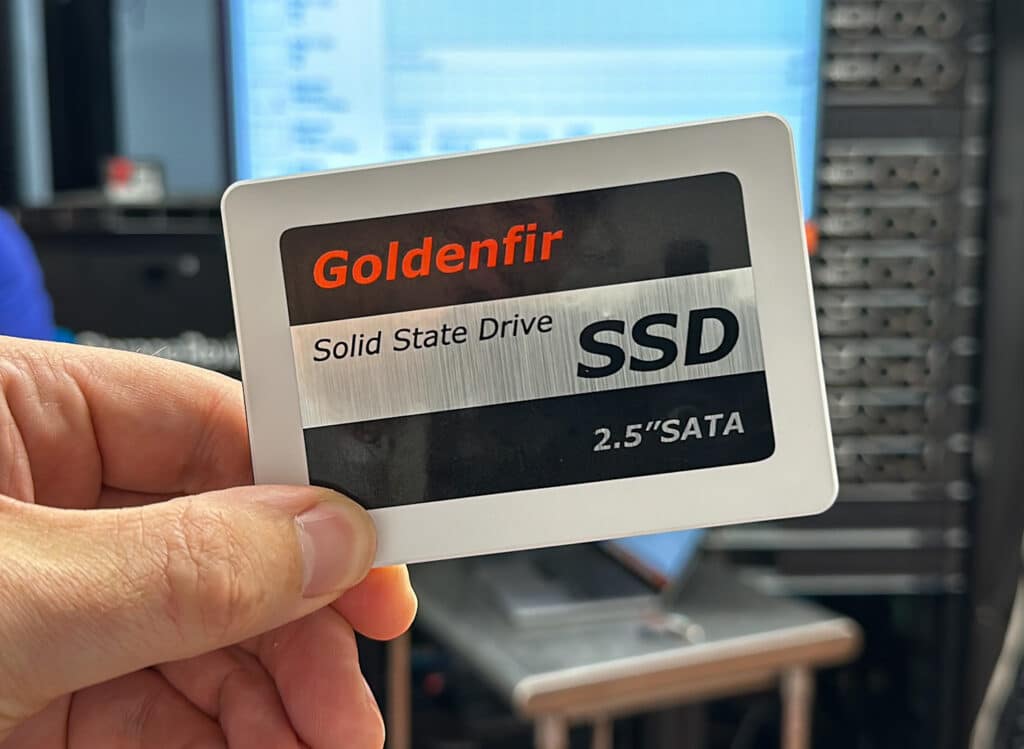
The Goldenfir brand is a name unfamiliar to me, along with most of the world. However, after a brief delve into some research, here’s what I uncovered: It is a Chinese technology company known for producing storage devices like SSDs (with rudimentary performance at best). Their specs and features feel like they are from a bygone era, and concerns about their longevity and reliability are evident. To say this SSD is unsuitable for critical tasks or as a primary drive in high-reliability systems would be an understatement—and that’s me putting it mildly. Undeterred, we will be looking at the 120GB model in this review.
Navigating the AliExpress Product Page
Let’s first dive product page on AliExpress to see if we can get a little more information. First, I went over their robust reviews section, where various buyers have generously given it 5-star reviews without even using it, claiming things like “Everything arrived, very fast delivery, I have not tested yet, but the product looks great quality.” They haven’t tested it yet?
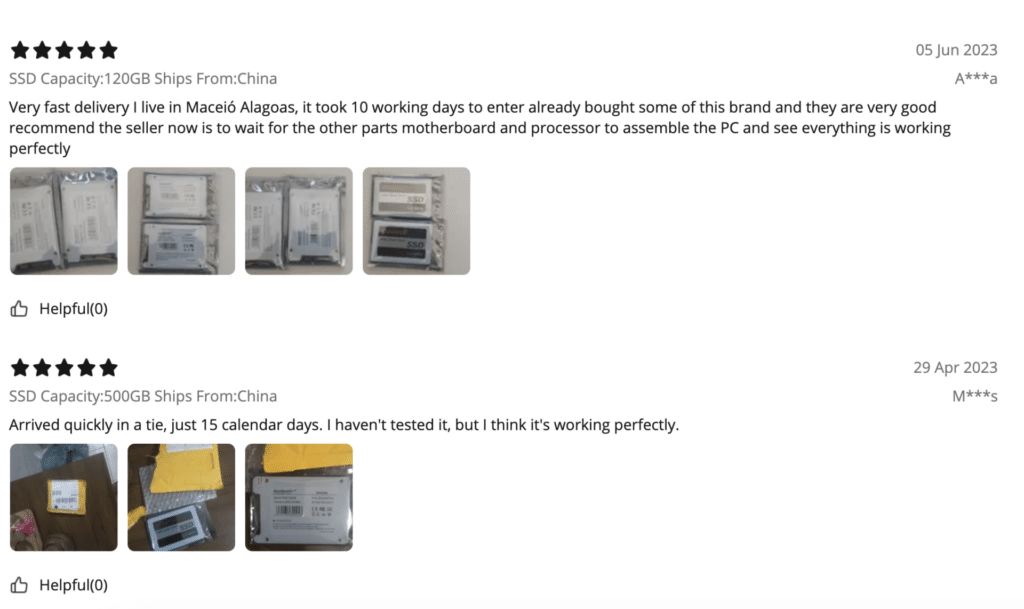
You might be saying “I guess in the realm of $3 SSDs, simply existing qualifies you for a 5-star review.” But that might not actually be the case given how inexpensive trusted, known-brand SSDs have become. Nonetheless, the SSD also boasts a “high-quality” trophy feature, which we assume is directly related to its incredible range of capacities, spanning 60GB to 2TB. Moreover, the listing assures us that this SATA SSD is “100% tested.” According to them, “We need several times and a few hours to test the SSD.” Clear as crystal, isn’t it?
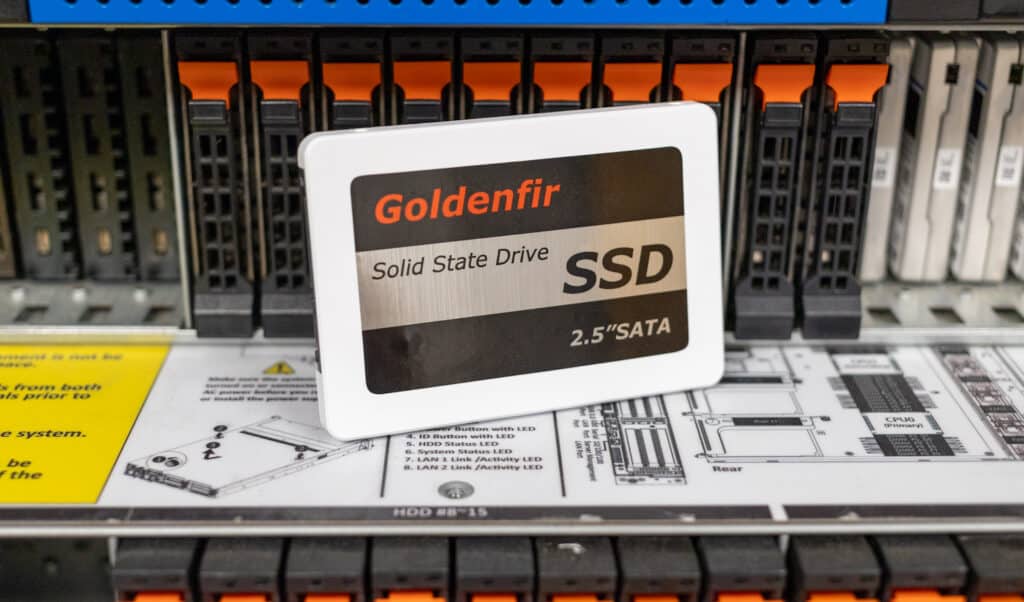
This “versatile” bad boy indicates that it is ready to run on Windows XP and DOS. So theoretically, the company invested time in testing and having firmware that supports these two ancient operating systems. While we don’t really have a way to verify this in the lab, let’s be honest, who wouldn’t want to relive the glory days of command-line interfaces on a brand-new SSD? But in all seriousness, support for older operating systems like these can certainly appeal to the retro-markets that still run legacy systems or require (extremely) low-resource solutions. A $3 SSD certainly would sound appealing to those fitting in this category.
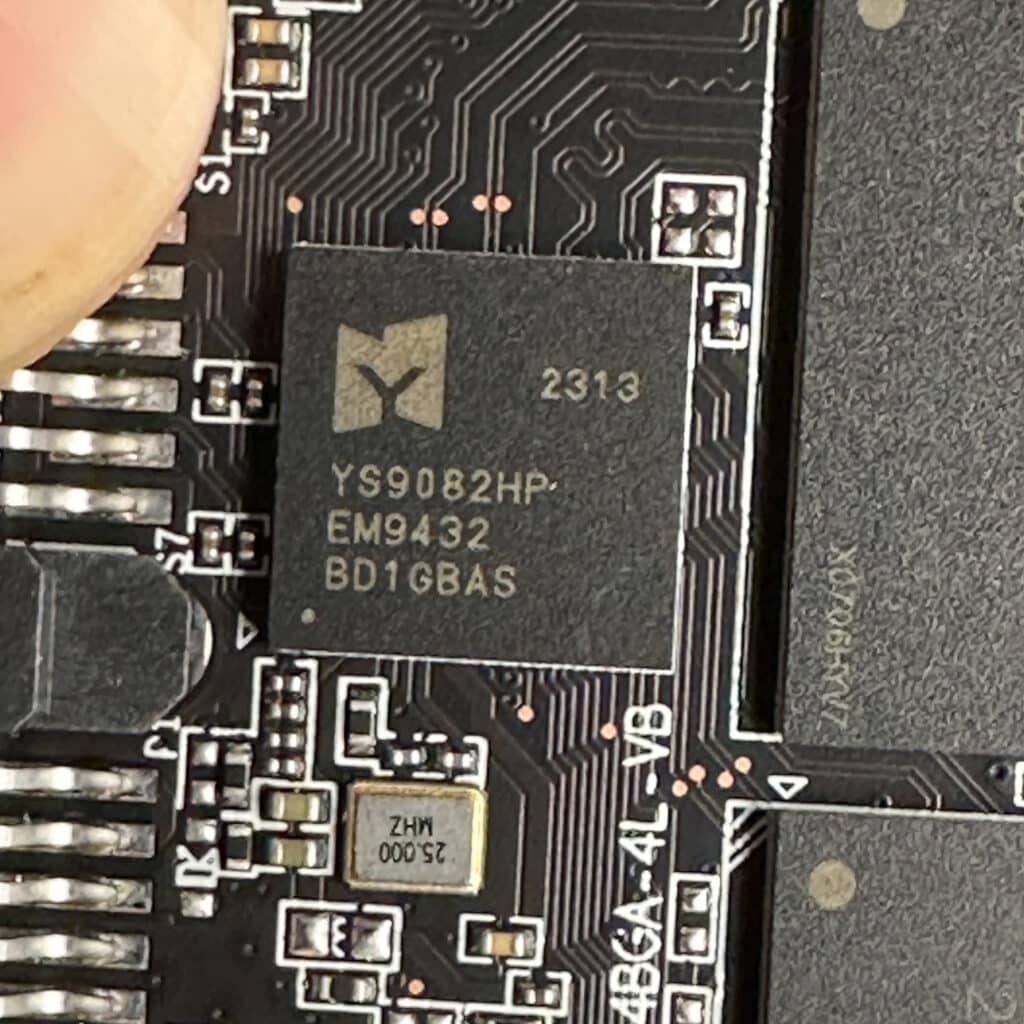
Allow us to introduce you to its controller: the YS9083XT. Again, thanks to StorageReview Discord user InfinityTick, we were able to find some information online about the YS9082HP SSD controller. It is described as a high-reliability, high-performance chip suitable for a variety of SSD form factors, including 2.5-inch, 1.8-inch, mSATA, M.2, and more. It offers support for multiple types of NAND Flash memory, such as 2D SLC, MLC, TLC, and 3D TLC/QLC. You’d think that this broad compatibility makes it a versatile option for different storage solutions. Technically, maybe so.
In terms of performance, it claims to offer sequential read speeds of up to 550MB/s and write speeds of up to 510MB/s or 450MB/s, depending on the version of the controller. Though these performance metrics harken back to the early days of consumer SATA SSDs, they are far from sluggish. It also throws around some IOPS numbers that are actually pretty respectable. But does it actually deliver on these numbers? Well, because of the guy who wasted our time testing this, you’ll have to keep reading to find out so we get the page view time and we get some ROI!
The $8 NVMe drive
If one shady product is not enough, the maniac sent two! We will also be looking at the 128GB NVMe Goldenfir drive, another cheap SSD found on AliExpress from the same company priced at around $8. This SSD features the SM2263XT, a budget-friendly NVMe SSD controller by Silicon Motion designed for use with TLC or QLC NAND flash, operating over a PCIe Gen3 x4 interface and NVMe 1.3 support…vintage 6 years ago.
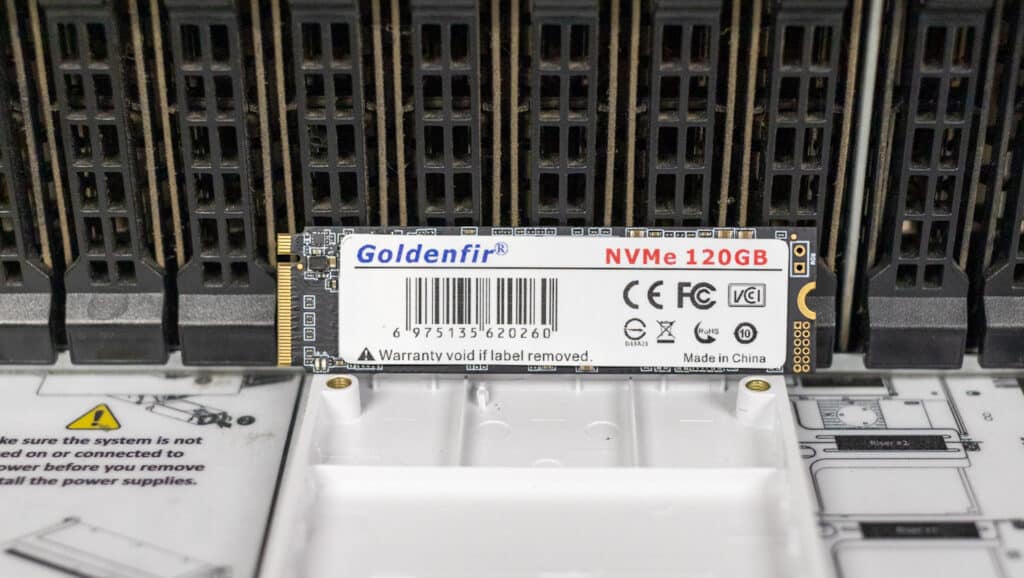
It is a DRAM-less controller, which means it lacks an onboard DRAM cache to speed up data transfers. Despite this, it theoretically offers decent performance for everyday tasks and light gaming. Again, you will see that it ultimately fails to deliver on any promise it might make on its product page.
So, Are These AliExpress SSDs Good for Anything… at all?
In all seriousness, while we jest about this “too-good-to-be-true” SSD, and the Discord user who sent it to us, there could theoretically be a use case for inexpensive drives such as these. Perhaps for temporary, non-critical storage, or for educational purposes to teach someone about how SSDs work without risking more expensive hardware. However, we wouldn’t recommend storing anything of value on it, and certainly not using it as an OS drive. As we mentioned above, a $3 SSD might not actually be worth it compared to the current pricing market of more trusted SSDs.
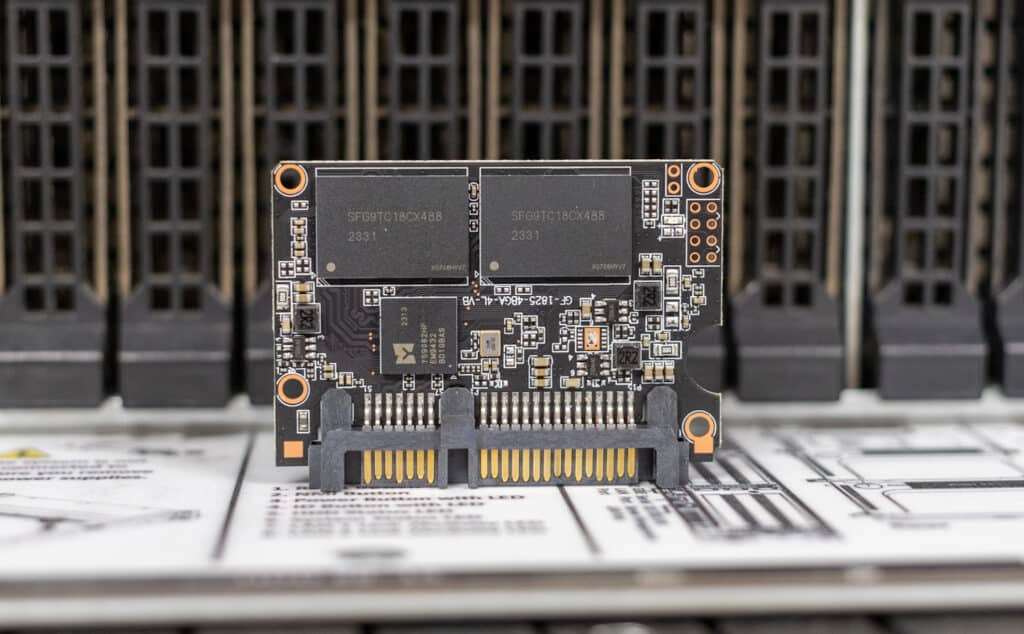
Ultimately, we don’t know whether to be amazed or terrified by this SSD. While we laugh at its claims (most of which were expectedly certainly lost in translation) as well as the SSD’s ambiguous specifications, remember this: as tempting as it may be to experiment with a $3 SSD, we strongly advise against it. Particularly this drive.
| $3 SSD Specifications | |
| Testing | 100% tested!!!!! |
| Interface and Compatibility | International standard SATA, SATA 3.0 with downward compatibility to SATA 2.0 |
| Supported Systems | Windows XP / 7 / 2003 / 2008, DOS, Linux, Unix |
| Application | Suitable for desktops, notebooks, mini computers, all-in-ones, and other commercial PCs |
| Quality Assurance | Years of SSD production experience, strictly tested one-by-one |
| Customer Service | Direct service from factory |
| Pricing | Factory direct sales |
| Warranty | Free replacement for three years |
| Controller | YS9082HP |
| Sequential Reads | 550 MB/s |
| Sequential Writes | 510 MB/s |
| Random Read Speed | 37,500 IOPS |
| Random Write Speed | 75,000 IOPS |
$3 SSD Performance
For database and synthetic testing, we leverage the Lenovo ThinkSystem SR635 server, equipped with an AMD 7742 CPU and 512GB of 3200Mhz DDR4 memory. NVMe is tested natively through an M.2 to PCIe adapter card in the edge-card slot. A large focus is put on drive latency across the entire load range of the drive, not just at the smallest QD1 (Queue-Depth 1) levels. We do this because many of the common consumer benchmarks don’t adequately capture end-user workload profiles. For our added BlackMagic Disk Speed Test performed in Windows, we use our self-built StorageReview desktop.
We will be comparing the $3 SSD with the following baller enterprise SSD:
We’re comparing it to the Kingston DC600M. While both drives share just one basic similarity—they store data—the comparison serves to illuminate just how vast the quality and performance gaps can be between he crappy SSD and an industry-leading enterprise SSD.
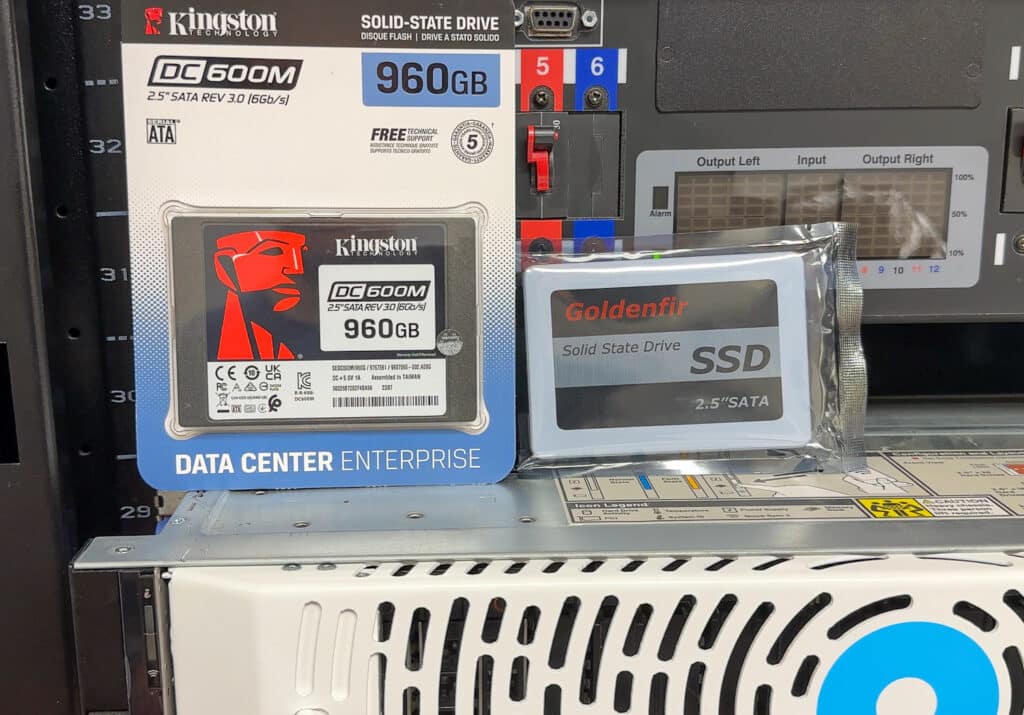
VDBench Workload Analysis
When it comes to benchmarking storage devices, application testing is best, and synthetic testing comes in second place. While not a perfect representation of actual workloads, synthetic tests do help to baseline storage devices with a repeatability factor that makes it easy to do an apples-to-apples comparison between competing solutions. These workloads offer a range of different testing profiles ranging from “four corners” tests, common database transfer size tests, to trace captures from different VDI environments.
All of these tests leverage the common vdBench workload generator, with a scripting engine to automate and capture results over a large compute testing cluster. This allows us to repeat the same workloads across a wide range of storage devices, including flash arrays and individual storage devices. Our testing process for these benchmarks fills the entire drive surface with data, then partitions a drive section equal to 1% of the drive capacity to simulate how the drive might respond to application workloads. This is different from full entropy tests which use 100% of the drive and take them into a steady state. As a result, these figures will reflect higher-sustained write speeds.
Profiles:
- 4K Random Read: 100% Read, 128 threads, 0-120% iorate
- 4K Random Write: 100% Write, 64 threads, 0-120% iorate
- 64K Sequential Read: 100% Read, 16 threads, 0-120% iorate
- 64K Sequential Write: 100% Write, 8 threads, 0-120% iorate
Goldenfir SATA Performance
Starting with the 4K random read test, the $3 SATA SSD essentially stopped working once it hit 15K IOPS where it skyrocketed in latency, ending the test at a laughable 13K IOPS and 10,225us. In comparison, the Kingston DC600M drive peaked at 78K IOPS and 1,630us.
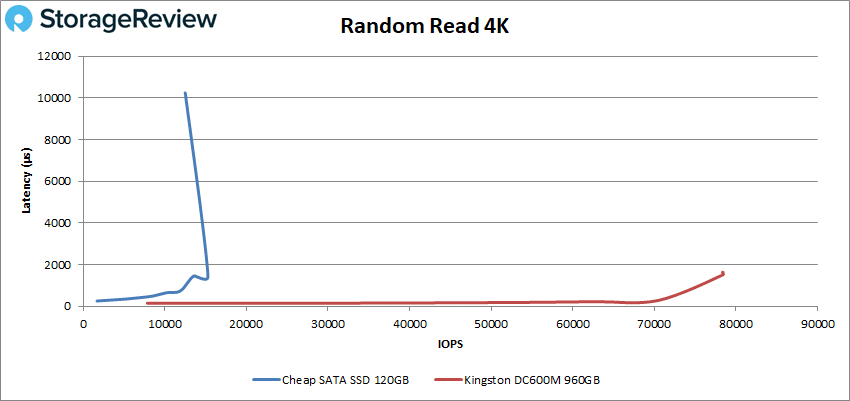
The results were even worse for 4K random writes, and I’m not going to bother mentioning actual numbers, so I’ll use this analogy: The Kingston drive looks like the Rolls-Royce, while the Goldenfir is akin to a questionable vehicle a shady car dealer might push on an unsuspecting buyer.
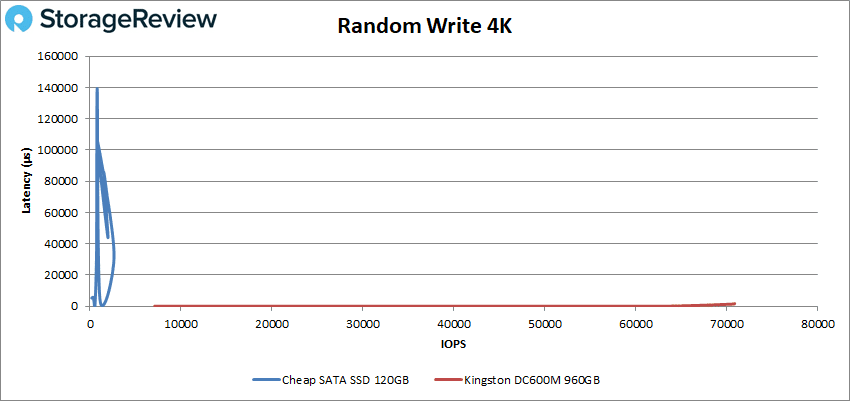
Next, we switched to sequential 64K tests where the cheap Goldenfir drive offered told a similar story, hitting just 48MB/s (600 IOPS) before latency shot up like a rocket, ending at a baffling ~43,000us.
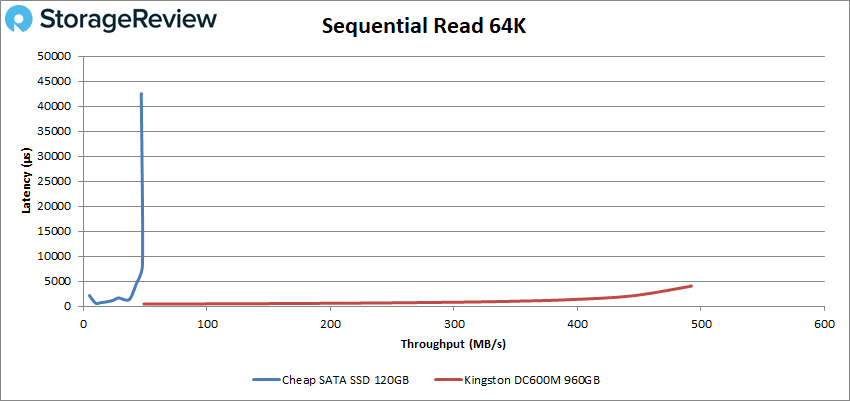
The Goldenfir showed us that it enjoys being terrible in sequential writes, ending the test at 19MB/s at 53,779us. I guess we should have compared the drive to a 10-year-old microSD card instead?
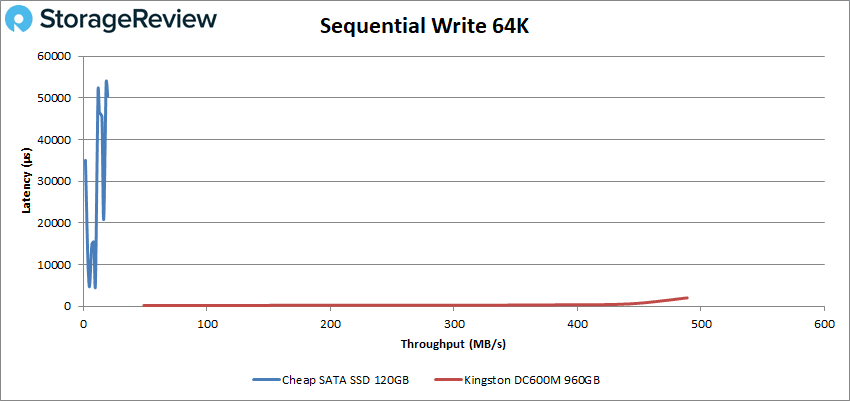
Goldenfir NVMe SSD Performance
In addition, we will be doing a separate set of tests for the 128GB NVMe Goldenfir drive and will be comparing it to some of the budget-friendly SSDs:
- Intel 670p (Gen3)
- Solidigm P41 Plus (Gen4)
Right off the bat with the 4K random read test, the Goldenfir barely made it out alive. Once it hit a measly 38K IOPS, latency skyrocketed to 3,924us. It ended the test at an abysmal 33K IOPS as well. In comparison, the Solidigm and Intel budget drives peaked at 219K IOPS and 295K IOPS, respectively.
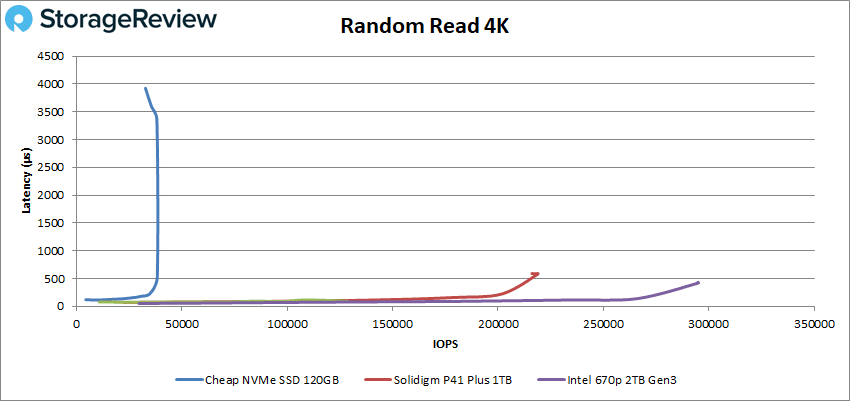
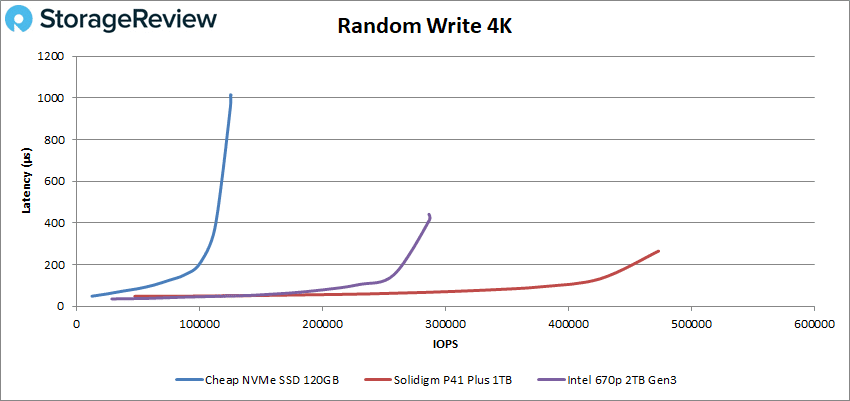
Next, we switched to sequential 64K tests where we added a few more drives to the mix for comparison. Unsurprisingly, the cheap Goldenfir drive offered nothing of worth when switching to these workloads as it hit just 13K IOPS at 2,494us when the test ended. The next best drive was the extremely affordable Intel 670p, which tripled the IOPS, while the top-performing Gen4 SSD was the Solidigm P41 Plus.
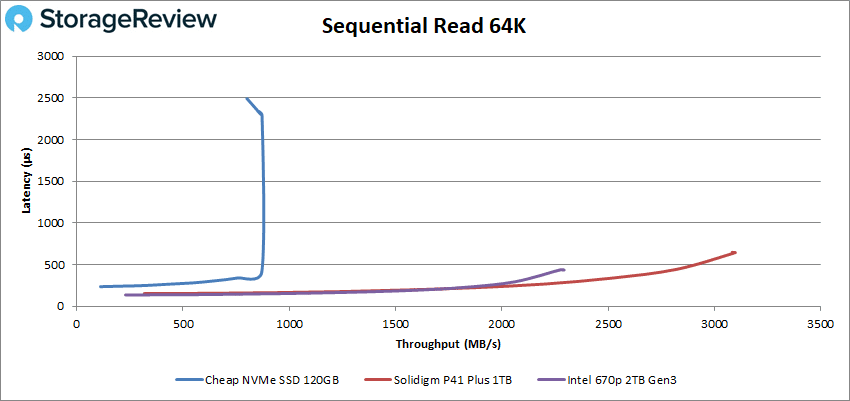
In sequential writes, performance halted as it reached 7,794 IOPS, ending with a latency of 1,854us. As you can see from the chart below, this was a fraction of the speeds boasted by the other lower-end budget-friendly drives.
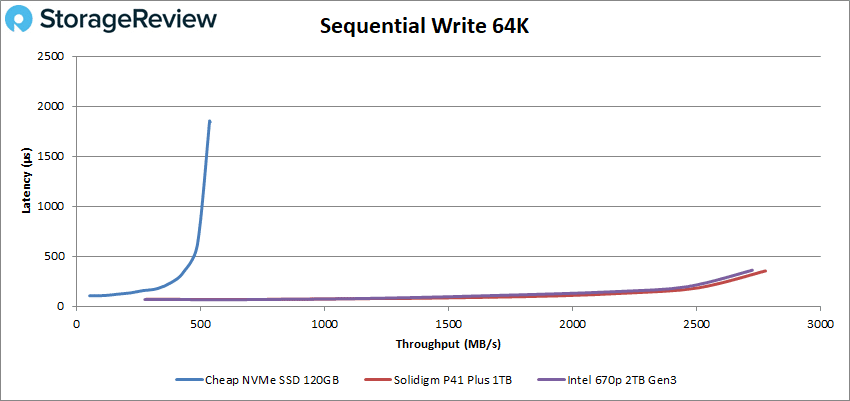
CrystalDisk Performance (SATA)
CrystalDiskMark (CDM) is a popular benchmarking tool, especially in the Windows environment, for evaluating a specific area of performance of storage drives. When testing the cheap SSD, we measured speeds that were (seemingly) satisfactory numbers: 554MB/s read and 518MB/s write at Q8T1. This result is comparable to recognizable drives like Kingston DC600M, which posted 567MB/s read and 541MB/s write. Here’s the screen from our YouTube video on the $3 SSD.
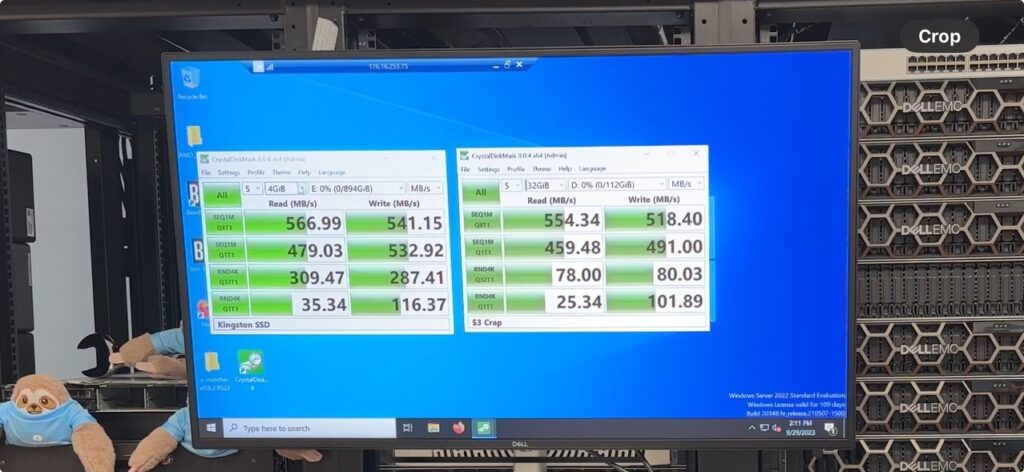
Completely ignoring the terrible vdBench results, you might be thinking, “So I guess it’s not that bad then, right? Maybe I should grab a few at that price!” However, we urge you to reconsider. CDM results can paint a deceptively rosy picture. It’s not the best metric for gauging sustained, non-burst performance, and there are a range of reasons as to why.
One of the main issues is that CDM (and other similar Windows-based disk speed benchmarking software) can mask true drive performance by leveraging host-side cache, especially in DRAM-less models like this cheap drive. As such, it creates an artificially inflated performance metric that may not be representative of real-world, sustained workloads.
In contrast, tests run in a Linux environment often focus on direct I/O (which is what we use), bypassing any cache mechanisms to reveal the actual speed and capabilities of the underlying drive. As such, while CDM might be useful for quick and comparative snapshots, it doesn’t offer a comprehensive view of how an SSD might perform under extended, real-world conditions. Given this context, we strongly urge reconsider if you’re using CDM as indicated. That is of course, unless you hate yourself.
Conclusion
Cheap drives found on digital stores like AliExpress are a curious bunch, to say the least. They may seem enticing due to their affordability; however, the potential risks they pose and their infinitytick-class (infinitytick is the name of the user who put us thorough this, so that’s our new word for crap) performance is often not worth the savings. And while they may (in some very rare situations) function fine for basic, mundane tasks, they simply don’t keep up with even budget trusted-brand alternatives in terms of speed or reliability. You shouldn’t be playing Russian roulette when it comes to your data.
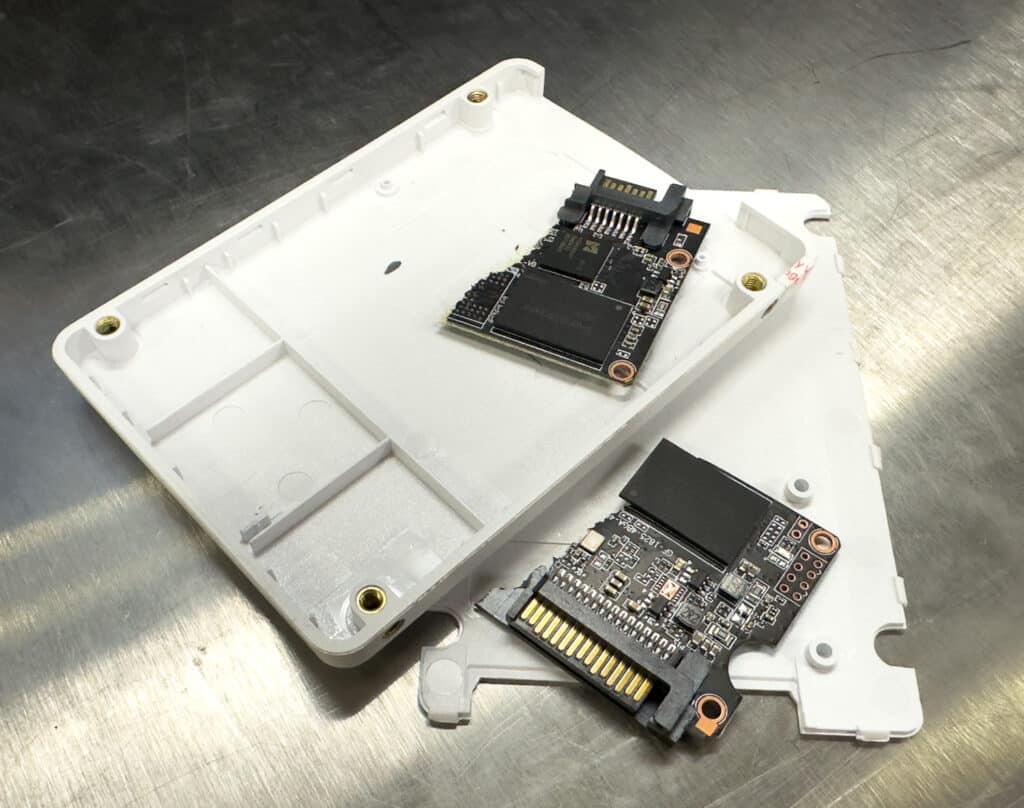
You might be asking yourself, “Why even bother with this review? I’d never buy cheap SSDs from a site like this.” Yet, many less-experienced consumers might be browsing AliExpress for affordable options, with 10,000 sold. Our hope is they stumble upon this review during a quick online search and make an informed decision. Plus it’s fun reviewing something you know is terrible before you do any testing and we are also all suckers for punishment here at StorageReview.
While I threw a lot of jokes around, it’s essential to get serious and underscore the genuine reasons these drives shouldn’t go near your rig, especially regarding performance. In our benchmarking, the Goldenfir SATA SSD severely underperformed (and we are being generous when we say “underperformed”). During the 4K random read and write tests, the drive struggled, displaying an abysmal latency, making the Kingston DC600M visibly leagues ahead.
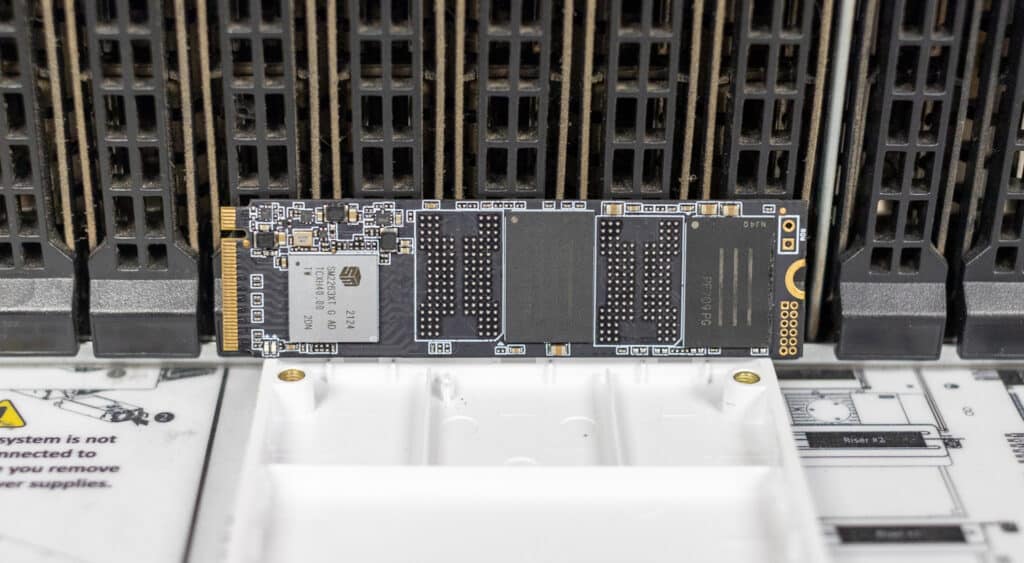
Similarly, the NVMe drive fumbled (then face-planted, losing several teeth, getting up again and blindly running into traffic for no reason, and getting hit by several cars in a row like John Wick) right out of the gate, with its performance paling in comparison to even budget offerings from Solidigm and Intel. The sequential 64K tests further highlighted the Goldenfir SSD’s shortcomings, with other drives like the affordable Intel 670p vastly outperforming it.
With all of this said drives like these sometimes do have a purpose. They could find a niche in very specific, non-critical applications. Perhaps you need a drive for a temporary project or to run some tests? Maybe you want to prank your friend, by simply giving them this drive? Or perhaps you’re gearing up for a rock-skipping championship? In those cases, a $3 SSD like this might make sense, as long as you’re fully aware of their vast limitations.
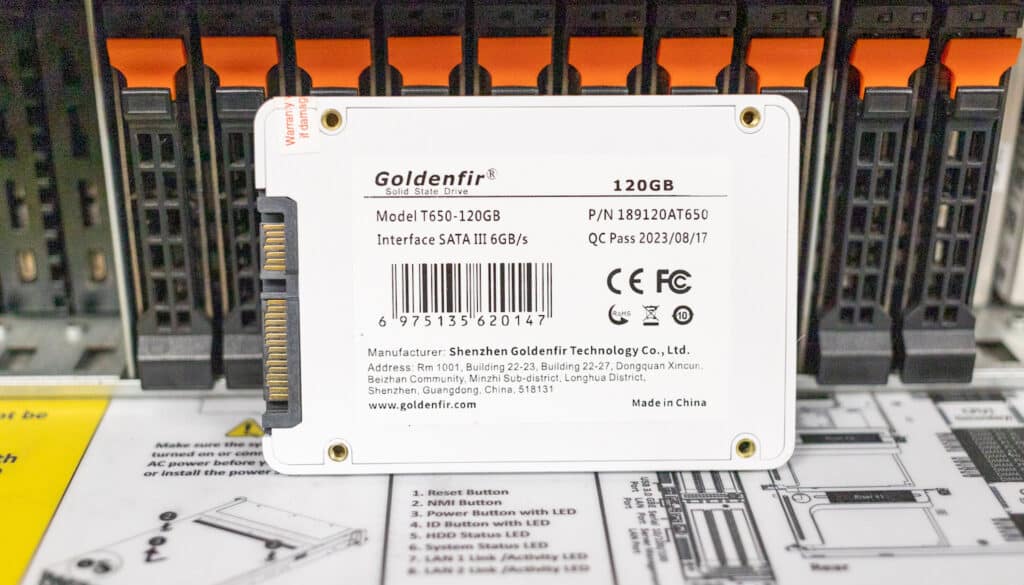
Think of them as the spork of the storage world: convenient in certain situations, but not something you’d use at a fancy dinner. Even then, we cannot fathom recommending these drives. Your best bet is to look for budget models. For example, The 1TB Intel 670P is often priced at $33 at places like Micro Center. To match this capacity using these cheap SSDs, you’d need to spend $64 and then configure them in RAID0. Heck, you’d be better off trying to turn a microSD card into a SATA drive; at least the effort and frustration might be more rewarding.
So, admire the oddity that is Goldenfir from a distance, but keep your data far, far away from these SSDs. We don’t want you to question your life choices if your data suddenly vanishes into the void.




 Amazon
Amazon